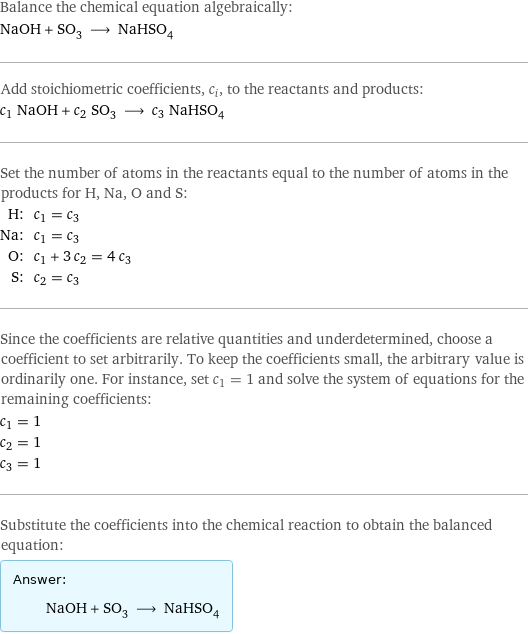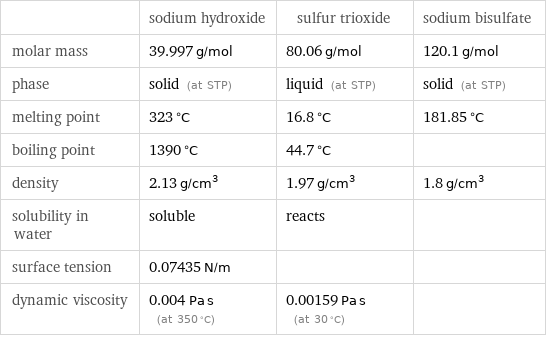Input interpretation

NaOH sodium hydroxide + SO_3 sulfur trioxide ⟶ NaHSO_4 sodium bisulfate
Balanced equation

Balance the chemical equation algebraically: NaOH + SO_3 ⟶ NaHSO_4 Add stoichiometric coefficients, c_i, to the reactants and products: c_1 NaOH + c_2 SO_3 ⟶ c_3 NaHSO_4 Set the number of atoms in the reactants equal to the number of atoms in the products for H, Na, O and S: H: | c_1 = c_3 Na: | c_1 = c_3 O: | c_1 + 3 c_2 = 4 c_3 S: | c_2 = c_3 Since the coefficients are relative quantities and underdetermined, choose a coefficient to set arbitrarily. To keep the coefficients small, the arbitrary value is ordinarily one. For instance, set c_1 = 1 and solve the system of equations for the remaining coefficients: c_1 = 1 c_2 = 1 c_3 = 1 Substitute the coefficients into the chemical reaction to obtain the balanced equation: Answer: | | NaOH + SO_3 ⟶ NaHSO_4
Structures

+ ⟶
Names

sodium hydroxide + sulfur trioxide ⟶ sodium bisulfate
Reaction thermodynamics
Gibbs free energy

| sodium hydroxide | sulfur trioxide | sodium bisulfate molecular free energy | -379.7 kJ/mol | -373.8 kJ/mol | -992.8 kJ/mol total free energy | -379.7 kJ/mol | -373.8 kJ/mol | -992.8 kJ/mol | G_initial = -753.5 kJ/mol | | G_final = -992.8 kJ/mol ΔG_rxn^0 | -992.8 kJ/mol - -753.5 kJ/mol = -239.3 kJ/mol (exergonic) | |
Equilibrium constant
![Construct the equilibrium constant, K, expression for: NaOH + SO_3 ⟶ NaHSO_4 Plan: • Balance the chemical equation. • Determine the stoichiometric numbers. • Assemble the activity expression for each chemical species. • Use the activity expressions to build the equilibrium constant expression. Write the balanced chemical equation: NaOH + SO_3 ⟶ NaHSO_4 Assign stoichiometric numbers, ν_i, using the stoichiometric coefficients, c_i, from the balanced chemical equation in the following manner: ν_i = -c_i for reactants and ν_i = c_i for products: chemical species | c_i | ν_i NaOH | 1 | -1 SO_3 | 1 | -1 NaHSO_4 | 1 | 1 Assemble the activity expressions accounting for the state of matter and ν_i: chemical species | c_i | ν_i | activity expression NaOH | 1 | -1 | ([NaOH])^(-1) SO_3 | 1 | -1 | ([SO3])^(-1) NaHSO_4 | 1 | 1 | [NaHSO4] The equilibrium constant symbol in the concentration basis is: K_c Mulitply the activity expressions to arrive at the K_c expression: Answer: | | K_c = ([NaOH])^(-1) ([SO3])^(-1) [NaHSO4] = ([NaHSO4])/([NaOH] [SO3])](../image_source/be2e2104bffc6110fcb6975534e0394a.png)
Construct the equilibrium constant, K, expression for: NaOH + SO_3 ⟶ NaHSO_4 Plan: • Balance the chemical equation. • Determine the stoichiometric numbers. • Assemble the activity expression for each chemical species. • Use the activity expressions to build the equilibrium constant expression. Write the balanced chemical equation: NaOH + SO_3 ⟶ NaHSO_4 Assign stoichiometric numbers, ν_i, using the stoichiometric coefficients, c_i, from the balanced chemical equation in the following manner: ν_i = -c_i for reactants and ν_i = c_i for products: chemical species | c_i | ν_i NaOH | 1 | -1 SO_3 | 1 | -1 NaHSO_4 | 1 | 1 Assemble the activity expressions accounting for the state of matter and ν_i: chemical species | c_i | ν_i | activity expression NaOH | 1 | -1 | ([NaOH])^(-1) SO_3 | 1 | -1 | ([SO3])^(-1) NaHSO_4 | 1 | 1 | [NaHSO4] The equilibrium constant symbol in the concentration basis is: K_c Mulitply the activity expressions to arrive at the K_c expression: Answer: | | K_c = ([NaOH])^(-1) ([SO3])^(-1) [NaHSO4] = ([NaHSO4])/([NaOH] [SO3])
Rate of reaction
![Construct the rate of reaction expression for: NaOH + SO_3 ⟶ NaHSO_4 Plan: • Balance the chemical equation. • Determine the stoichiometric numbers. • Assemble the rate term for each chemical species. • Write the rate of reaction expression. Write the balanced chemical equation: NaOH + SO_3 ⟶ NaHSO_4 Assign stoichiometric numbers, ν_i, using the stoichiometric coefficients, c_i, from the balanced chemical equation in the following manner: ν_i = -c_i for reactants and ν_i = c_i for products: chemical species | c_i | ν_i NaOH | 1 | -1 SO_3 | 1 | -1 NaHSO_4 | 1 | 1 The rate term for each chemical species, B_i, is 1/ν_i(Δ[B_i])/(Δt) where [B_i] is the amount concentration and t is time: chemical species | c_i | ν_i | rate term NaOH | 1 | -1 | -(Δ[NaOH])/(Δt) SO_3 | 1 | -1 | -(Δ[SO3])/(Δt) NaHSO_4 | 1 | 1 | (Δ[NaHSO4])/(Δt) (for infinitesimal rate of change, replace Δ with d) Set the rate terms equal to each other to arrive at the rate expression: Answer: | | rate = -(Δ[NaOH])/(Δt) = -(Δ[SO3])/(Δt) = (Δ[NaHSO4])/(Δt) (assuming constant volume and no accumulation of intermediates or side products)](../image_source/67d5cb89f7fdf3d3a70dd2d59307dbdb.png)
Construct the rate of reaction expression for: NaOH + SO_3 ⟶ NaHSO_4 Plan: • Balance the chemical equation. • Determine the stoichiometric numbers. • Assemble the rate term for each chemical species. • Write the rate of reaction expression. Write the balanced chemical equation: NaOH + SO_3 ⟶ NaHSO_4 Assign stoichiometric numbers, ν_i, using the stoichiometric coefficients, c_i, from the balanced chemical equation in the following manner: ν_i = -c_i for reactants and ν_i = c_i for products: chemical species | c_i | ν_i NaOH | 1 | -1 SO_3 | 1 | -1 NaHSO_4 | 1 | 1 The rate term for each chemical species, B_i, is 1/ν_i(Δ[B_i])/(Δt) where [B_i] is the amount concentration and t is time: chemical species | c_i | ν_i | rate term NaOH | 1 | -1 | -(Δ[NaOH])/(Δt) SO_3 | 1 | -1 | -(Δ[SO3])/(Δt) NaHSO_4 | 1 | 1 | (Δ[NaHSO4])/(Δt) (for infinitesimal rate of change, replace Δ with d) Set the rate terms equal to each other to arrive at the rate expression: Answer: | | rate = -(Δ[NaOH])/(Δt) = -(Δ[SO3])/(Δt) = (Δ[NaHSO4])/(Δt) (assuming constant volume and no accumulation of intermediates or side products)
Chemical names and formulas

| sodium hydroxide | sulfur trioxide | sodium bisulfate formula | NaOH | SO_3 | NaHSO_4 Hill formula | HNaO | O_3S | HNaO_4S name | sodium hydroxide | sulfur trioxide | sodium bisulfate
Substance properties

| sodium hydroxide | sulfur trioxide | sodium bisulfate molar mass | 39.997 g/mol | 80.06 g/mol | 120.1 g/mol phase | solid (at STP) | liquid (at STP) | solid (at STP) melting point | 323 °C | 16.8 °C | 181.85 °C boiling point | 1390 °C | 44.7 °C | density | 2.13 g/cm^3 | 1.97 g/cm^3 | 1.8 g/cm^3 solubility in water | soluble | reacts | surface tension | 0.07435 N/m | | dynamic viscosity | 0.004 Pa s (at 350 °C) | 0.00159 Pa s (at 30 °C) |
Units
